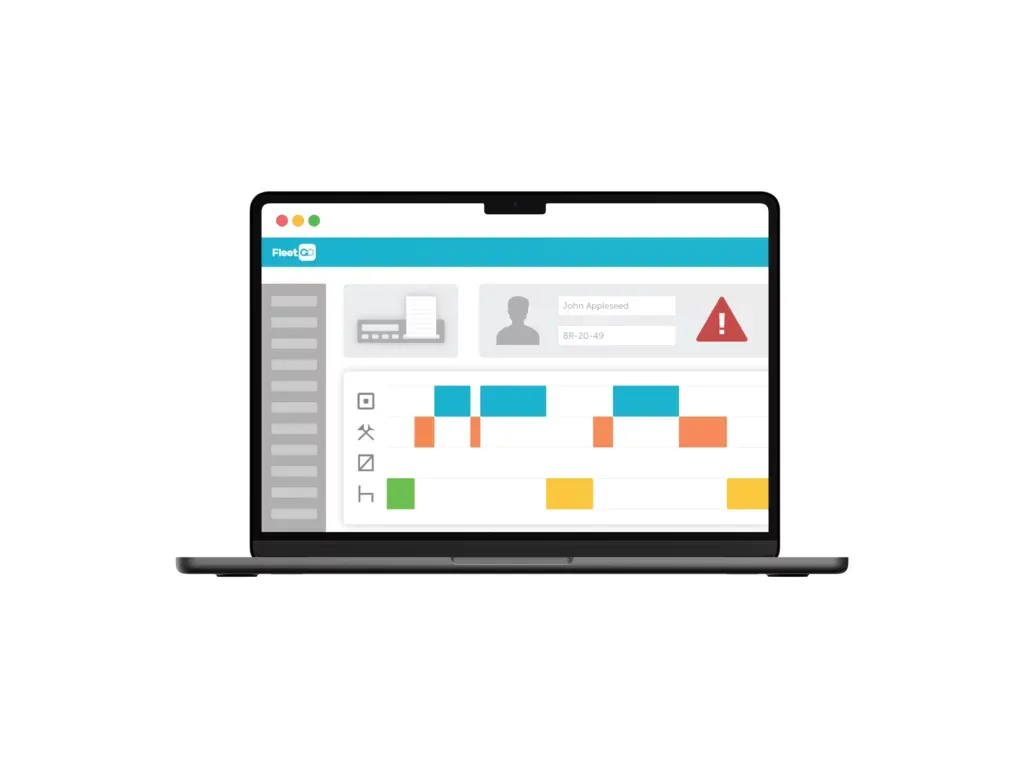In the UK, there are a number of specific legal regulations pertaining to HGV driving hours. These regulations are in place to improve drivers’ working conditions and balance out the competition between different types of inland transport, particularly within the road transport sector. What’s more, and perhaps most importantly, they are designed to make driving on roads and motorways across the country as safe as possible.
Lorry driving is an occupation that requires high levels of concentration for prolonged periods of time. As a result, lorry drivers commonly experience fatigue — a prominent cause of road traffic accidents. Reaction times, attention span and awareness are all significantly impaired by tiredness, resulting in drivers being less able to control their vehicle. Worldwide, it is estimated that 10-20% of all crashes are caused by tiredness at the wheel.
In this article, we provide a comprehensive overview of the HGV driving hours regulations that haulage companies should keep in mind. In doing so, they can ensure the safety of their drivers and other road users, and avoid legal infringements.
Download the HGV Driving Hours UK Cheat Sheet
Get it for FREE!

Tacho Rules Quiz
Do you think you know all the rules regarding driving and rest times? Test your knowledge with our Tacho Rules Quiz!
Take the FleetGO Tacho Quiz
UK HGV Driving Hours
When it comes to HGV driving hours in the UK, the rules are the same as those which apply across the EU. Drivers of all goods vehicles or vehicle and trailer combinations with a maximum permissible weight of over 3.5 tonnes must adhere to these regulations. Only those covered by a specific EU-wide exemption or a UK derogation may disregard them.

Regulations state that drivers must not be behind the wheel for more than 9 hours in any one day. This limit may be increased to 10 hours twice per week. However, employers must gain consent from their drivers through a workforce agreement should they wish to extend the standard 9-hour shift to a 10-hour shift.
Each week, no more than 56 hours may be driven. This is usually calculated over a rolling 17-week period, but haulage companies may extend this to 26 weeks providing that their drivers formally agree. In spite of this, the total number of weekly working hours must not total more than 60 — this is however dependent upon whether the 56-hour average weekly limit has been exceeded.
In any consecutive two-week period, the maximum number of driving hours that may be logged is 90. All of the hours driven must be recorded using a tachograph — a practical device located in the cab of the vehicle.
Domestic HGV Driving Hours
The UK domestic HGV driving hours are applicable to drivers whose vehicle or vehicle combination has a maximum permissible weight of under 3.5 tonnes and is being driven on public roads during employment or in connection with a trade or business. These domestic rules also apply to the majority of all goods vehicles over 3.5 tonnes that are exempt from following the standard EU rules when driven in the UK.
Duty time
For HGV drivers who are employed by a company, duty time is considered to be any time spent working. For self-employed HGV drivers, only the time that is spent driving or undertaking any work associated with the vehicle and its goods is regarded as duty time.
Daily driving
It is forbidden to exceed the 10-hour daily driving limit on public roads as well as off-road outside of duty time. Any off-road driving undertaken for the purposes of agriculture, quarrying, forestry, building work and civil engineering is considered duty time.
Daily duty limit
Being on duty for over 11 hours on any one working day is prohibited. All drivers must log their hours using a weekly timesheet or tachograph.
Never risk any tachograph fines again!
Get started with analysing your tachograph files with the FleetGO all-in-one tacho solution. Never miss an infringement again!
Chances of getting invested are higher than ever!

HGV Driving Hours App
The handy FleetGO app is a simple and reliable way for hauliers to ensure that they are fully compliant with all of the HGV driving hours regulations.
The app is synchronised with the FleetGO Cloud platform and our CubiQ hardware. This device is easy to install and is connected to the tachograph. It registers and analyses a range of important tachograph data — including driving hours and rest periods— and transmits this to the FleetGO Cloud platform and mobile app. Here, the data is displayed via an intuitive, user-friendly interface, making it easy for HGV drivers and their employers to avoid violating HGV driving hours regulations and maintain safe driving conditions.
HGV Driving Hours Working Time Directive
The HGV driving hours working time directive sets out all of the rules that HGV drivers and their employers must observe.
All vehicle-related activities undertaken by the driver are included in their working hours. These activities include:
- Operating the vehicle
- Loading and unloading the vehicle
- Complying with correct workplace practices and training
- Vehicle maintenance
- Ensuring goods are contained appropriately
- Maintaining an up-to-date record of all legal documentation
- Tracking time between shifts
Driving is, of course, the main activity, which is recorded using a tachograph. This device maintains a log of important driver and vehicle data, such as driving time, rest periods and availability. Using this insightful data, haulage companies can ensure their drivers are complying with legal regulations and carrying out their tasks as expected.
HGV Driving Hours and Breaks
Regardless of where hauliers are driving to, haulage companies must ensure that their drivers take the HGV driving hours breaks required by law.
In total, drivers must take at least 11 hours rest per day. During driving hours, HGV drivers are obliged to take a 45-minute rest period after being behind the wheel for 4.5 hours. All breaks taken must be no shorter than 15 minutes.
In addition, drivers must adhere to the necessary break requirements when they carry out other tasks related to their vehicle. Here, the HGV working time directive sets out a so-called 6-hour rule. In other words, drivers must not work for more than 6 hours without a break during hours when they are not driving.
Here is an overview of the length of breaks that must be taken during working time:
- 15-minute break after 6 working hours
- 30-minute break after working 6-9 hours
- 45-minute break after 9 working hours
Break rules during driving hours are stricter than those set out during work time, given that there is greater room for accidents whilst drivers are out on the road.
HGV Driving Hours: Split Breaks
To provide HGV drivers with the necessary support during longer, more challenging shifts, rest breaks may be split. The total daily rest period of 11 hours may be divided into two periods — a minimum of three and nine hours of daily rest.
Three times a week, the daily rest period may be reduced to 9 hours. However, hauliers must be mindful that this will be recorded as a reduced daily rest period.
HGV Driving Hours Made Simple
Here are some of the most important driving hours and break regulations for HGV drivers in a nutshell,
- The maximum daily driving time is 9 hours.
- The daily driving time may be increased to 10 hours up to twice per week.
- Each week, lorry drivers can be behind the wheel for a maximum of 56 hours.
- In a two-week period, the total driving time must not exceed 90 hours.
- Drivers must take a rest period of at least 11 hours per day.
- If the daily rest period is reduced, this must not fall below 9 hours. Drivers may only do this 3 times in every 2 weekly rest period.
- The unreduced daily rest period may be split into two — the first break must last for at least three hours and the second for at least 9 hours.
- Drivers must take a break of at least 45 minutes after 4.5 hours of continuous driving.
FAQs
HGV drivers must drive for no longer than 9 hours per day. In a week, HGV drivers can drive their vehicle for a maximum of 56 hours and for up to 90 hours over two consecutive weeks.
This varies from driver to driver. Some may choose to work the maximum number of daily and weekly driving hours — 9 hours and 56 hours respectively — while others may work shorter shifts that fall below these thresholds.
Lorry driving requires sustained levels of concentration and many drivers work long shifts that may fall during unsociable hours of the day. As a result, drivers must take up to 11 hours worth of breaks each day, which can be split into two periods.
HGV drivers hours are a set of legal regulations that stipulate the maximum number of commercial driving hours and required rest periods for hauliers. Any drivers operating vehicles of over 3.5 tonnes must abide by these rules to prevent road traffic accidents from occurring as a result of fatigue.
HGV drivers may drive for no longer than 9 hours a day, 56 hours each week, or 90 hours over two weeks. There are certain possible extensions to these limits, which drivers must formally agree to with their employer.
Disclaimer
This content is provided for informational purposes only and is not meant to be an endorsement or representation by FleetGO.com or any other party. This information may contain inaccuracies or typographical errors, despite our efforts to ensure accuracy. FleetGO.com accepts no responsibility or liability for any errors or omissions, and is not responsible for the contents of any linked website or any link contained in a linked website. Please refer to our full disclaimer for more details.


